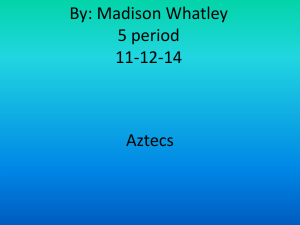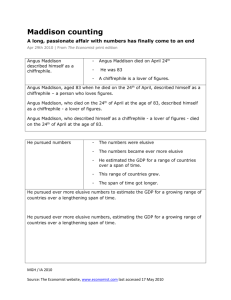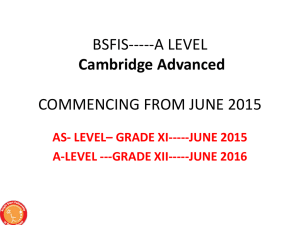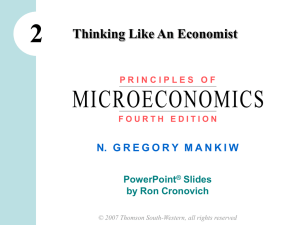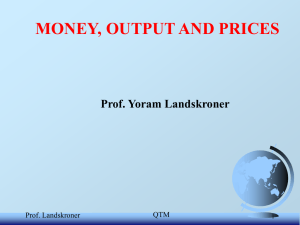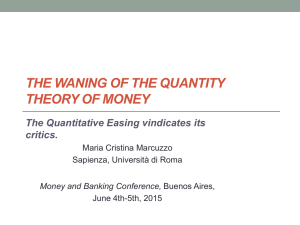The Quantity Theory of Money
advertisement
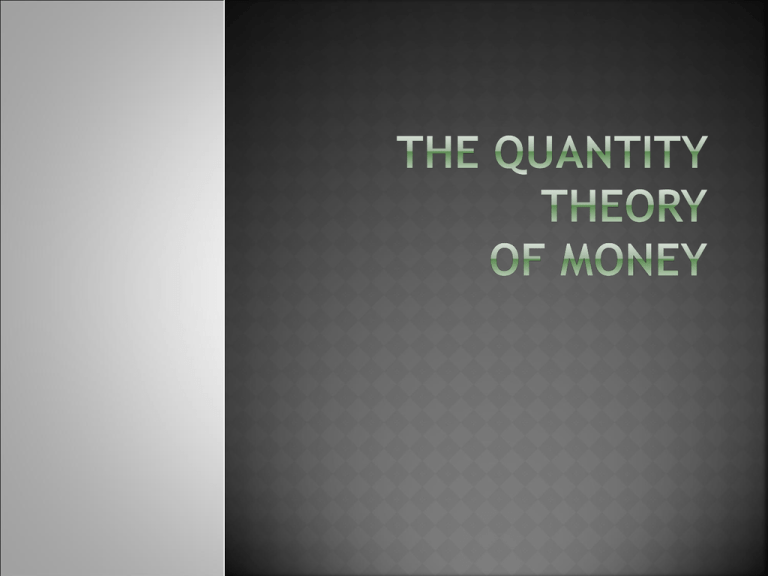
The idea that the money supply will directly impact both prices and inflation rates, ceteris paribus Lived from 1473 to 1543 First astronomer to formulate the Heliocentric Cosmology Brought monetary reform to Poland and Prussia through understanding of connections between money supply and price levels Monetae Cudendae Ratio(1526) was written by request of Sigismund I, King of Poland and presented to the Prussian Diet describing an early form of QTM Lived from 1711 to 1776 Scottish philosopher, historian, and economist Anti-mercantilist Wealth was measured by the stock of commodities of a nation not by the stock of the money Of Money(1752) – “It is none of the wheels of trade: it is the oil which renders the motion of the wheels more smooth and easy” “If we consider any one kingdom by itself, it is evident, that the greater or less plenty of money is of no consequence; since the prices of commodities are always proportioned to the plenty of money…” “Were they to make use of their native subjects, they would find less advantage from their superior riches, and from their great plenty of gold and silver; since the pay of all their servants must rise in proportion to the public opulence” Argument that increased in-flow of bullion into a nation would result in increased domestic prices, and therefore change terms of trade between the nations These increased prices would then result in a decreased demand for exports and an increased demand for foreign imports, thus resulting in the flow of specie out of the nation Reversal in terms of trade between nations Lived from 1867 to 1947 American economist, health campaigner, and eugenicist Most famous for Fisher “equation of exchange” put forth in his book The Purchasing Power of Money(1911) M V = P T as most simplified version Where V and T are both assumed constant Direction of causation from left to right, showing money supply’s importance Velocity of money is fixed because of “institutional factors”, i.e. the money supply being exogenous Classical dichotomy states that nominal and real variables can be analyzed separately, so: Output is determined in real variables, velocity will remain unchanged because it is derived from the money supply divided by price Fisher also assumed that there is no propensity to hoard and always full employment This equation is based on the idea that money is simply used as a medium of exchange and not for any speculative or precautionary purposes Lived from 1842 to 1924 English economist Father of Cambridge neoclassical approach Recognized money as a store of value and not just a medium of exchange Believed there would always be some temporary storing of wealth to hedge against future uncertainties Marshall and fellow neoclassical economists would focus more on what was happening in the real world as opposed to idealized conditions represented by classical mathematical models This meant discovering answers to things such as how people deal with future uncertainties and the explanation of business cycles Lived from 1877 to 1959 English neoclassical economist Prize student of Alfred Marshall at Cambridge Univ. Exemplified Marshall’s Neoclassical approach to economics Equation of exchange rewritten as M/P = kY or M/P = (1/V)Y “k” represents the famous Cambridge constant Differs from velocity because k has the ability to fluctuate, while velocity always remained constant k relies on things such as the opportunity cost of holding money and a person’s wealth Lived from 1883 to 1946 British economist, student of Alfred Marshall at Cambridge Took different approach to QTM than neo’s Viewed money not as a commodity, but as an asset with a price relative to other assets given by the cost of holding money, which is the interest rate Did not believe that changes in the money supply would lead to a directly proportional change in the price levels More concerned with the elasticity of prices in response to changes in aggregate demand and the behavior of people His concerns with the actual working economy led to the development of his liquidity preference theory, which is the preference of an individual to hold their money instead of investing it in things such as government bonds M/P = L(r,Y) Represents the amount of liquid cash people will desire given a certain interest rate and at a certain income Keynes viewed money as a close substitute for other financial assets because these assets serve as a store of value “Substitution effect” – interest elasticity of money demanded varies with respect to the desire to substitute cash for other financial assets Precautionary motive – motive for holding cash due to uncertainty about future rates of interest Transactions motive – implies a person will prefer liquidity to assure they can make market transactions, mostly determined by a person’s income Keynes insight in monetary theory led to a paradigm shift in the field of economics Lived from 1912 to 2006 American economist, Statistician, and public Intellectual Led the Monetarist incarnation of Chicago School Opponent of Keynsian economics and wanted to show that money mattered Believed that the money supply was an important instrument in conducting economic policies Money is an asset with certain unique characteristics which cause it to be a substitute for all assets, both real and financial An excess supply of money and excess money balances would not only be spend on bonds but on things such as consumer durables View contends that money demanded in interest inelastic and therefore the demand for money will be unresponsive to changes in the interest rate Main concerns were with the connection between price movement and changes in the supply of money, and the relationship between price changes and changes in output In the short-run a change in the money supply would affect output, while in the long-run, price levels would be changed Believed monetary policy was key in controlling price levels and inflation, promoted a steady, pre-determined fixed growth rate on the money supply Studies on the Quantity Theory of Money(1956) QTM “was a theoretical approach that insisted the money does matter- that any interpretation of short term movements in economic activity is likely to be seriously at fault if it neglects monetary changes in repercussions and if it leaves unexplained why people are willing to hold the particular nominal quantity of money in existence” Attributed the cause of the Great Depression to faulty, tight monetary policy The Federal Reserve contracted the money supply, thus creating a financial shock Had the Fed used easy monetary policy much of the Great Depression could have been avoided




